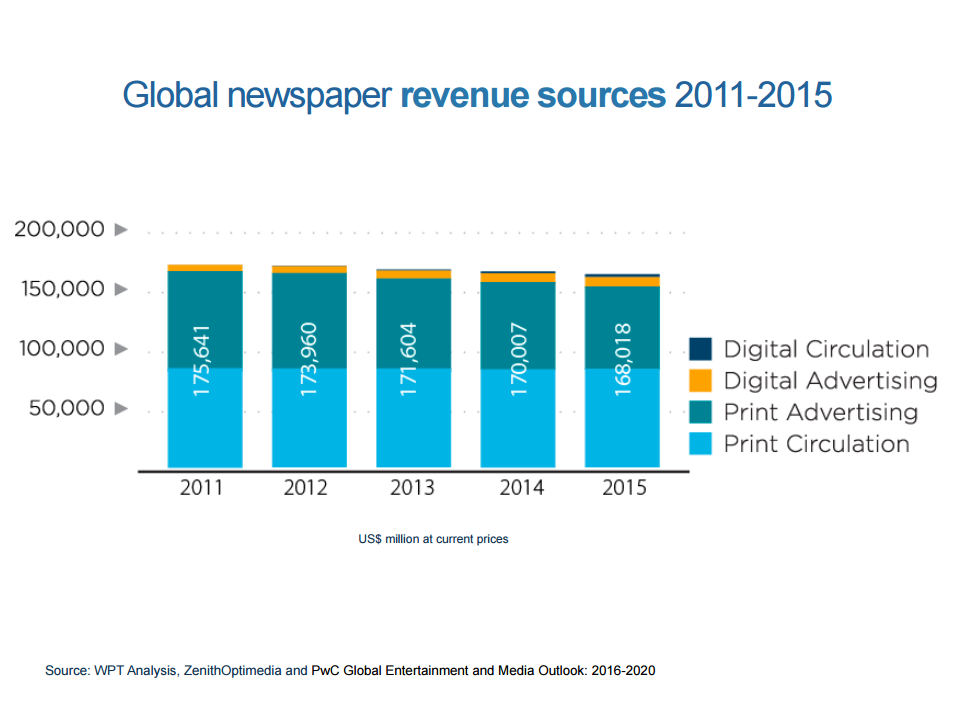In an effort to get their content in front of more readers, newspapers are increasingly striking deals with technology companies like Facebook to cross-post articles on their platforms.
The practice, referred to as distributed content, is one of the most significant recent upheavals to the news industry, according to the annual World Press Trends survey for 2016, produced by the World Association of Newspapers and News Publishers (WAN-IFRA).
The report’s findings — which surveyed newspaper associations across the globe — show that global newspaper readership is rising, particularly digitally and on mobile devices. For instance, it’s estimated that at least 40 percent of global internet users read newspapers online.
However, part of this increase is due to newspapers publishing stories directly on Facebook (through its Instant Articles feature), Google, Twitter and other technology platforms.
Teemu Henriksson, a project coordinator at WAN-IFRA, told IJNet that every year there are certain hot topics in the news business that come to light when the survey data is compiled. Distributed content is one phenomenon the industry is still figuring out.
“Some say it’s one of the biggest developments to happen in the news industry, while others say it is potentially a risky move to surrender control over distribution and monetization of your content to third parties,” he said. “No one really knows what the right mix will be for these things, but the trend in the industry seems to be to try things out, experiment and share findings.”
Henriksson added that while news publishers used to be more or less in control of their content, producing journalism has become more complex, from distributing news to reaching audiences.
“News publishers need to be aware that they’re losing the autonomy,” he said. “They’re becoming a part of this bigger ecosystem and they have to make choices about collaborating with other players in it."
James Breiner, an analyst of new media trends and entrepreneurship, also said that the onslaught of distributed content is yet another way newspapers are losing control of their brands.
“Readers don’t even know what media organization was the source of the original article, so that’s a problem,” he said. “The whole point of major media is the strong brand that people can trust, especially with all the noise on the internet.”
Another hot topic causing headaches for publishers is ad blocking. The report’s survey data found that at least 419 million people — or 22 percent of the world’s 1.9 billion smartphone users — are blocking ads on the mobile web, which caused mobile ad blocking to climb an astounding 90 percent in 2015.
The fact that readers are taking such proactive steps to avoid disruptive and low-quality advertising should rightfully concern newspapers and their management, Breiner said.
“Publishers are all very scared and realizing that they are guilty of causing this problem by creating intrusive, annoying, ugly advertising,” he said.
In response to the rise of ad blockers, some news publishers are attempting to rely on native advertising. However, Breiner cautioned that not all native ads are created equal. Like articles, native advertising won’t work if it doesn’t offer value to readers, he said.
 However, most newspapers currently get their revenue from their audience, rather than ads, the WAN-IFRA report noted. In 2015, US$90 billion, or 53 percent of total global revenue for newspapers, came from paying subscribers.
However, most newspapers currently get their revenue from their audience, rather than ads, the WAN-IFRA report noted. In 2015, US$90 billion, or 53 percent of total global revenue for newspapers, came from paying subscribers.
Overall, media companies are becoming more focused on their audiences, Henricksson said. Publishers are holding events to strengthen ties to the communities they serve and gain new revenue, as well as initiating full-fledged membership models.
Honing in on a niche audience is actually the best way forward for newspapers, according to Breiner, who insists that newspapers are mostly losing the game of scale to Google. Instead, newspapers should develop “loyal audiences, not big audiences.”
“What you really want is people who come back to your content again and again,” he said. “If you have your own mobile app, your users are in your app, you own them. What you want to have is such good content on your daily email bulletin or on your mobile app that people come there every day. Media organizations can do that. They still have the ability to do that.”
World Press Trends has been published by WAN-IFRA since 1989. More of the survey’s data can be found in a searchable database. Those interested in contributing data about working in journalism to another ongoing survey can do so here.
Main image CC-licensed by Flickr via Esther Vargas. Secondary image courtesy of WAN-IFRA's World Press Trends report.

